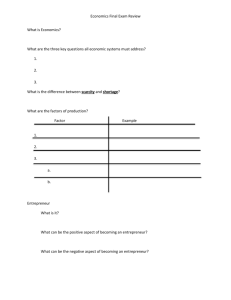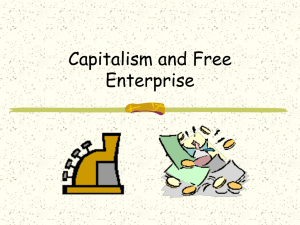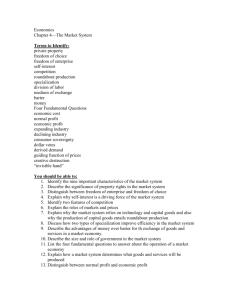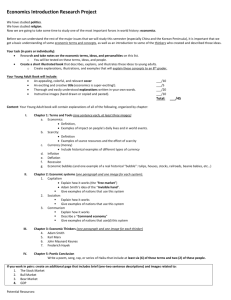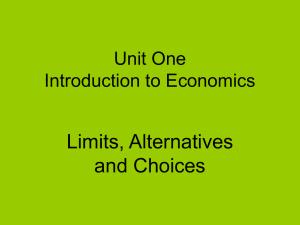Unit One Introduction to Economics
advertisement
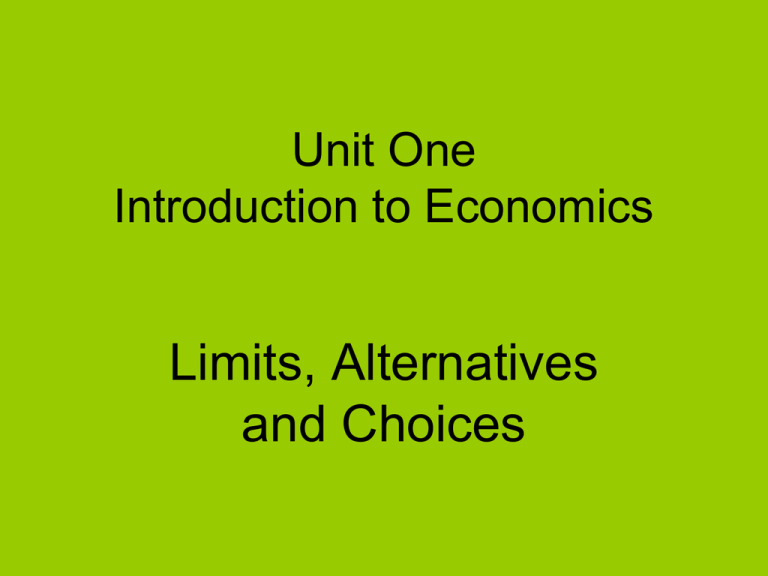
Unit One Introduction to Economics Limits, Alternatives and Choices The Science of Economics depends on the Scientific Method • The Scientific method is used to develop theories and principles to explain the likely effects/impact of human behavior (social science.) • The Scientific method is a decision making process which includes: identifying the problem, stating a hypothesis, gathering data, analyzing data, testing the hypothesis and then developing theories & principles (laws.) • The Scientific method is also known as the “Economic Model” and uses scientific research to create & support economic generalizations. Economists develop economic theories & principles at two levels • MACROECONOMICS: focuses on the whole or entire economy, large segments. • The “Forest” • Issues at this level include economic growth (GDP), Inflation (CPI), Employment (Unemployment Rate) • Keynesian versus Classical economics • MICROECONOMICS: targets specific units in the economy. • The “Trees” • Issues at this level include how prices & output are determined for particular products & how consumers react to price changes (*The law of supply & demand.) Economic studies at the Macro or Micro level may be either: • Positive economics • • • • which investigates facts. “What Is” Hard data or just the numbers. The unemployment rate, the GDP, the Core CPI. The GDP for last quarter was 1.5%. The unemployment rate was 7.5% last year. • Normative economics incorporates a subjective view. • “What ought to be” or value-based economics. • Political/economic policies to address economic issues. • The government should cut taxes to stimulate economic growth. The Economizing Problem • The economizing problem arises from a conflict between economic wants and economic resources. • Economic “wants are unlimited” while economic “resources are limited” (wants exceed the available resources). • The economizing problem is also known as the “problem of scarcity.” • Scarcity forces individuals and societies to make choices or decisions on how to allocate their scarce or limited resources. • Efficient and wise decision-making should take into account both opportunity costs (next highest alternative) & tradeoffs (everything given up). Choices are necessary! Economic Resources The Factors of Production (inputs) • Land includes all natural resources “gifts of nature” used in production. Forests, minerals, oil, water are all examples of land. “Chindia” China & India are employing larger amounts of this resource. Approximately 2.3 billion people. • Labor consists of the physical and mental talents of individuals. Services provided by workers. Karl Marx believed that workers did not receive the “Value of their Labor” under capitalism. • Capital or capital goods includes all manufactured aids used in production (tools, machinery, buildings.) Purchases of capital are known as “Investment”. Capital is not money in the world of economics. • The Entrepreneur is the individual that displays the ability to “combine” land, labor and capital to produce a good or service. The entrepreneur is an innovator, “risk bearer” who is not guaranteed a profit in a pure market economy. Bill Gates is the world’s wealthiest person and an entrepreneur. Circular Flow of Business Activity – Free Market Role of GOVERNMENT ??? CONSUMERS BUSINESS • Goods & Services • Wages Supply & Demand • Purchases • Labor Production Possibilities Curve Moving from “A” to “B” – less resources (land, labor, capital, entrepreneurship) will be devoted to military goods and more will be devoted to civilian goods Military Goods 5 A 4 3 B 2 1 0 1 2 3 4 Civilian Goods 5 Economic Systems Every society needs to develop an economic system to respond to the economizing problem of scarcity. Economic systems differ as to who owns the “factors of production” and the method used to coordinate and direct economic activity (voluntary exchange or central planning.) Two Major Economic Systems A Command system may also be called socialism or communism. The government owns or controls most of the factors of production & uses central planning. Russia & other nations have transitioned to mixed market economies. North Korea, Cuba, Iran, Libya, Laos, Belarus remain command systems. A Market economy may also be called capitalism or free enterprise system. It is characterized by the private ownership of resources and uses markets & prices to coordinate and direct economic activity. Participants are guided by self-interest (Adam Smith & the invisible hand.) Pure capitalism or laissezfaire capitalism (“let it be”) does not exist. The Five Fundamental Questions #1 What will be produced? In a market system the types and quantities of goods to be produced is based on profit. If firms are making a profit the good will be produced. The greater the profit the larger the quantity being produced (vice versa for losses.) In a Command system the types and quantities of goods produced & services provided have typically been determined by a central planning committee (5 year plan of the Soviet Union.) Consumer sovereignty is crucial in determining the types & quantities produced. Consumers spend their income through “dollar votes.” Dollar votes ultimately determine which industries exist and which fail. The Five Fundamental Questions #2 How Will Goods & Services Be Produced? This question focuses on the various combinations of resources and technology used to produce goods or services ( “mix of the factors”.) The “mix of the factors” is directly related to minimizing costs (outsourcing and off-shoring,) because competition eliminates high-cost producers, especially in a global economy. The most “efficient production technique” depends on the available technology and the prices of necessary inputs (land, labor, capital, and entrepreneurial ability.) The Five Fundamental Questions #3 Who Will Get the Output? Who will receive the distribution (allocation of resources) of total output depends on the consumers willingness and ability to pay the existing market price. Income is a key determinant of consumption and was a primary concern of Karl Marx (The Father of Modern Scientific Socialism) in relation to capitalism. Proletariat, the “Have-nots” and Bourgeoisie, the “Haves.” The amount of income a consumer has is dependent on numerous factors, but include the quantities of the property and human resources they supply (land, labor, capital, and entrepreneurial ability.) Resource prices (wages, interest, rent, profit) are crucial in determining the size of a person’s income and therefore their ability to consume. The Five Fundamental Questions #4 How Will the System Accommodate Change? Market systems are very dynamic and possess the incredible feature of changing quickly in relation to consumer preferences (consumer sovereignty & dollar votes.) Always in “Flux.” Resources can be reallocated very quickly in a market system, because of “voluntary exchange.” The Law of Supply & Demand explains how the “market” will adjust to prices and quantities. Surpluses or Shortages of a good or service cause market prices to lower/increase, encouraging an increase/decrease in the quantity demanded, and a decrease/increase in the quantity supplied. The market is always in search of the equilibrium. The Five Fundamental Questions #5 How Will the System Promote Progress? Society desires economic growth (greater output) and higher standards of living. To accomplish these goals the economy must promote technology & capital accumulation. A Market system by its very nature encourages technological advancement (profit incentive.) An entrepreneur or firm that introduces a popular new product or finds new methods of production increases profit and reduces costs. In a Market system there is a rapid spread of technological advancement throughout an industry. A “creative destruction” may take place. The creation of new products and production methods destroys the market positions of firms unwilling to move forward. Technology advances require additional capital goods. Adam Smith & the “Invisible Hand” • In his book, The Wealth of Nations (1776), Adam • • Smith noted that market systems create a unique bond between private interests & social interests. Firms and individuals (resource suppliers) seek their own self-interest which creates a framework for competition. Firms maximize profits and households maximize incomes. The desire of individual firms and households to gain maximum satisfaction (self-interest) guides the market system without the need for government involvement. Thus an “Invisible Hand” Three Major Virtues of a Market System Efficiency of resources takes place in a market system as they are guided into the production of goods & services most desired by society. There are both, allocative (“guns or butter”) and productive (lowest per unit production cost) efficiency. Incentives encourage workers to sell their labor for income and entrepreneurs to take risks & innovate for profit. Freedom, both personal and economic is the foundation of a market system. Central planning uses coercion to coordinate economic activity, a market system is guided by “self-interest” and “voluntary exchange.” •The Demise of the Command System Command systems throughout the world have been vanishing. From the Soviet Union, to nations throughout eastern Europe, and even China. Transitions to market economies have been fast & furious. Two insurmountable problems have caused this demise. #1 The Coordination Problem involves the failure of central planners to coordinate consumers, resource suppliers and businesses. Market systems are guided by the law of supply and demand. Prices, consumer sovereignty, dollar votes and profit incentive determine “what & how much is produced.” Central planning has led to extreme shortages and surpluses in command economies, creating environments futile for uprisings and revolution. #2 The Incentive Problem involves the inability of a command system to motivate both workers and producers. Workers unable to demand higher incomes for greater productivity, simply maintain the status quo. Entrepreneurs have no incentive to risk or innovate, because the reward of profit is nonexistent. Influential Economists Adam Smith: 1723-1790, Scotland “An Inquiry into the Nature & Causes of the Wealth of Nations 1776.” Invisible Hand & “Laissez-Faire David Ricardo: 1772-1823, London “Principles of Political Economy & Taxation 1817.” Comparative Advantage Karl Marx: 1818-1883, Germany “The Communist Manifesto 1848, and Das Kapital: A Critique of Political Economy 1876.” Class Struggles & Labour Theory of Value John Maynard Keynes: 1883-1946, Cambridge, England “The General Theory of Employment, Interest & Money 1936.” Deficit Spending, Aggregate Demand, Macroeconomics “In the long run we are all done.”

